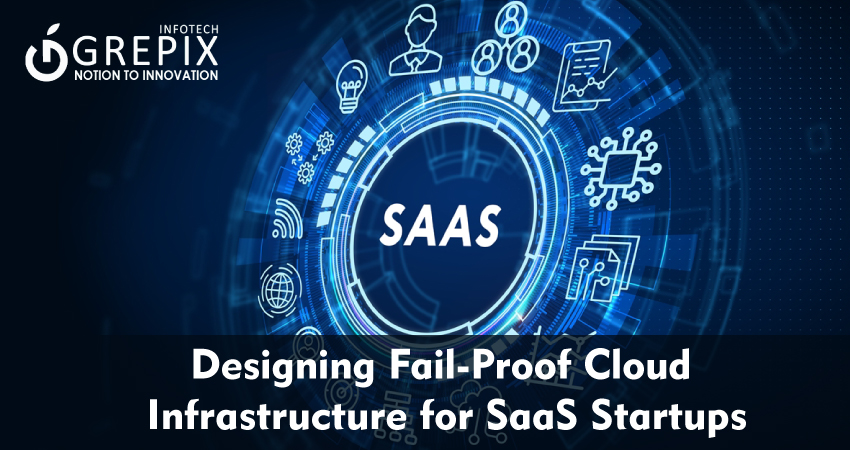Designing Fail-Proof Cloud Infrastructure for SaaS Startups
Building a fail-proof cloud infrastructure is mission-critical for SaaS startups. In the world of Software-as-a-Service, even minor outages can violate SLAs, erode customer trust, and harm the business. “If your platform suffers from availability issues, you will lose customers, breach SLAs and invalidate contracts. Your business will not last,” as one SaaS engineering leader put it
Modern SaaS cloud architecture must therefore prioritize high reliability, scalability, security, and efficiency from day one. This article outlines cloud-agnostic best practices – with examples from AWS, Azure, and Google Cloud for designing a high availability cloud setup that can scale with your startup, protect customer data, and recover from failures with minimal downtime.
We’ll cover scalable infrastructure for startups, cloud infrastructure best practices for redundancy, secure SaaS hosting strategies, proactive monitoring, CI/CD and DevOps integration, multi-region redundancy for disaster recovery, and cost optimization. By the end, you’ll have a roadmap and a handy checklist for building a “fail-proof” infrastructure that keeps your SaaS running smoothly through growth and adversity.
Designing fail-proof cloud infrastructure is crucial for SaaS startups aiming to deliver reliable, secure, and scalable services in today’s competitive market. The referenced guide highlights the advantages of several cloud models—including IaaS, PaaS, serverless, and Kubernetes—while emphasizing the importance of matching infrastructure choices with business growth and mobile app development needs. Case studies reveal that startups benefit from cloud platforms by enhancing agility, controlling costs, and maintaining security through best practices such as data isolation and compliance audits. The blog advocates for automated CI/CD pipelines, robust monitoring, and disciplined cost management to minimize operational risks and cloud waste. Key insights include the use of scalable architectures, real-time monitoring tools, and prioritizing security-first infrastructure to maintain customer trust and success. By focusing on these strategies, SaaS startups are empowered to build and manage cloud infrastructures that support long-term growth, customer satisfaction, and competitive advantage in the fast-evolving SaaS landscape.
Designing Fail-Proof Cloud Infrastructure for SaaS Startups
The number one reason SaaS startups struggle isn’t a lack of innovation—it’s infrastructure failure. Did you know over 44% to 57% of cloud migration attempts fail, costing SaaS products millions in lost revenue and customer trust? If building resilient, scalable, and cost-efficient infrastructure for mobile app development or SaaS products is your concern, read on for expert solutions powering market leaders.
Why SaaS Startups Need Robust Cloud Infrastructure
Meeting Growth and Reliability Demands
- The global SaaS product market is set to reach $390.5 billion in 2025.
- Startups use an average of 106 SaaS applications in 2024, highlighting consolidation and scalability needs.
- Mobile app development in the SaaS space demands uptime, rapid deployment, and seamless scaling.
Transactional and Informational Search Intent Answered
People Also Ask:
- How do SaaS startups avoid cloud failures?
- What infrastructure best fits SaaS products?
- Which cloud models empower mobile app development security?
Cloud Infrastructure Types for SaaS Startups
1 Cloud Virtual Machines (IaaS)
- Maximum control, but complex setup for SaaS startups.
- Examples: AWS EC2, Azure VMs.
2 Platform as a Service (PaaS)
- Abstracts hardware/OS management for rapid mobile app development.
- Examples: AWS Elastic Beanstalk, Azure PaaS.
3 Serverless (Function as a Service/FaaS)
- No runtime worry; fast deployment and scaling for two-sided SaaS products.
- Examples: AWS Lambda, Azure Functions.
4 Kubernetes (Container Orchestration)
- Best for multitenant SaaS startups with growing product features.
- Most recommend using managed Kubernetes for future-proofing.
5 Low-Code/Zero-Code Platforms
- Quick MVP creation but limited for growth; risky for established startups.
Decision Framework for SaaS Startups
| Factor | Cloud Virtual Machines | PaaS | Serverless | Kubernetes | Low Code |
|---|---|---|---|---|---|
| Admin Overhead | Hard | Easy | Easy | Medium | Easy |
| Time to Market | Hard | Medium | Easy | Medium | Easy |
| Agility | Hard | Hard | Easy | Easy | Easy |
| Control | Easy | Hard | Hard | Easy | Hard |
| Cost | Easy | Medium | Hard | Easy | Hard |
| Migration | Easy | Hard | Hard | Medium | Hard |
| Integration | Hard | Hard | Easy | Easy | Easy |
Top Concerns for SaaS Cloud Infrastructure
- Security: Data isolation, enhanced access control, strong authentication practices.
- Reliability: High availability architectures, disaster recovery across regions.
- Cost: Pay-as-you-go models, avoiding overprovisioning in early stages.
- Scalability: Automated scaling with Kubernetes, Serverless, and cloud-native databases.
Also Read: "Designing Fail-Proof Cloud Infrastructure for SaaS Startups"
Real-Life Case Studies
Case Study: Texture Energy
Uturn Data Solutions modernized Texture Energy's SaaS platform using AWS. The outcome was higher performance, better scalability, and improved security, allowing seamless scaling as customer needs changed.
AWS Cloud Infrastructure in India
A large non-profit used AWS IaaS to centralize user authentication and endpoint security for its SaaS-based HRMS & Prism applications. Benefits included streamlined management and secure user connections.
Failure Example: Adleaf Technologies
SaaS startup Adleaf overspent on infrastructure and lacked financial discipline—leading to shutdown. Key lesson: Smart cost control and infrastructure planning are vital.
How to Design a Fail-Proof Cloud Infrastructure
1 Assess Needs & Growth
- Map SaaS product requirements: user load, performance, customization, regulatory compliance.
2 Choose the Right Cloud Model
- Start with managed Kubernetes for control and scalability.
- For quick market entry, leverage PaaS/Serverless.
- Avoid low-code/zero-code for anything beyond MVP.
3 Implement Security Best Practices
- Encrypted storage, strong access policies, routine audits.
- Follow compliance standards (ISO, GDPR, SOC 2).
4 Automate CI/CD and Monitoring
- Use cloud-native CI/CD pipelines (AWS CodePipeline, Azure DevOps).
- Monitor with CloudTrail, CloudWatch.
5. Optimize Cost and Scale
- Use auto-scaling, pay-as-you-go pricing.
- Monitor cloud spend; avoid “cloud waste”.
6 Plan for Migration and Integration
- Ensure cloud agnosticism where possible.
- Document configs and dependencies for smooth migration.
External Authoritative Sources
- AWS: Guide to Building SaaS on AWS
- Azure: Secure SaaS Infrastructure Recommendations
- Gartner: Cloud Adoption Reports
Conclusion
Building fail-proof cloud infrastructure is central to the success and growth of SaaS startups, especially those focused on mobile app development and scalable SaaS products. Focus on matching infrastructure choices to business needs, automate for agility and reliability, and use robust security and cost optimization tactics. Ready to future-proof your SaaS product? Begin your transformation—and share this guide to help others build resilient startups!
Grepix Infotech stands as a trailblazer in mobile app development, consistently delivering top-tier solutions for businesses worldwide. With over a decade of experience and a highly skilled team, Grepix has become the preferred partner for startups, enterprises, and on-demand service providers seeking innovative digital transformation. The company’s expansive portfolio includes custom mobile applications, dynamic web development, UI/UX design, and advanced digital marketing, all crafted with user-centric principles and industry best practices
FAQs
1. What’s the best cloud model for mobile app development in SaaS startups?
Kubernetes and Serverless are optimal for scaling, automation, and flexibility, matching most SaaS product needs.
2. How can SaaS startups reduce cloud infrastructure costs?
Use auto-scaling features, pay-as-you-go billing, and monitor usage to avoid unnecessary spend (“cloud waste”).
3. Which security practices protect SaaS cloud environments?
Isolate data, apply role-based access, audit frequently, and ensure regulatory compliance.
4. How do SaaS startups avoid downtime?
Design for high availability, leverage multi-region deployments, use managed services for failover.
5. What is SaaS migration, and when should it be planned?
Migration refers to moving to new cloud providers or models plan early, document thoroughly, and choose platforms supporting cloud agnosticism.
Launch your vision with our mobile app development company, where innovation meets excellence to create cutting edge mobile solutions."







